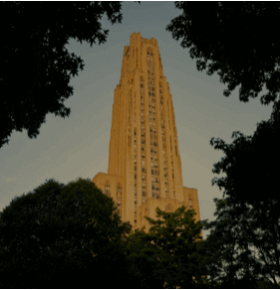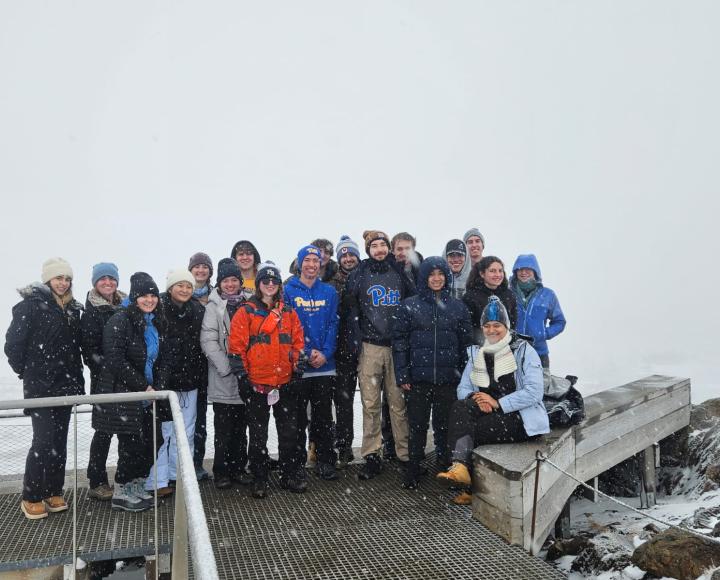
Subscribe to Pittwire Today
Get the most interesting and important stories from the University of Pittsburgh.Clad in construction helmets and electric green safety vests, 22 Pitt students walked onto a snow-packed field dotted with chrome geodesic domes linked by a maze of pipes. They arrived in the otherworldly landscape of the Hellisheidi Geothermal Power Plant just hours after their plane touched down in Keflavík, Iceland. It was day one of the University’s spring break, but these students were engaged in learning.
This semester, the Swanson School of Engineering launched Sustainable Engineering in Iceland: Culture, History and Innovation, a three-credit course taught by Matt Barry, an associate professor of materials and mechanical science. The study abroad course, which combined classroom lessons and a weeklong field experience, was Pitt’s first faculty-led excursion to Iceland.
“Iceland’s ethos is conservation. Their technology, their commitment to carbon neutrality and their drive to make processes better is inspiring,” said Barry.
“My goal was to have students gain a holistic understanding of Iceland’s engineering practices, including the influences of history and culture,” he added.
Students spent spring break touring highlights of eastern and southern Iceland, including glaciers, black sand beaches and a volcanic crater — the Northern Lights even made an appearance. Daily, they reflected on their adventures in an online travelogue, and you can read all of their reports on the course site.
Lessons from the ground
Iceland is an island about the size of Kentucky. Still, it plays an outsize role in global geothermal ingenuity. Most simply, geothermal energy extraction taps into the Earth’s crust, bringing hot water and steam to the surface. This technology has countless applications: Hot water can be diverted to homes and greenhouses for heating and channelled under sidewalks and roads to melt ice and snow. Steam is used to drive turbines and generate electricity.
Geothermal sources currently account for 66% of Iceland’s primary energy use. The nation also hosts the Unesco Geothermal Training Programme to support developing countries' adoption of geothermal technology.


Iceland’s geological makeup makes it uniquely suited to produce geothermal energy, said Barry. The country is one of the most active volcanic regions on Earth thanks to its location over the Mid-Atlantic Ridge where North American and Eurasian tectonic plates are slowly drifting apart, making space for magma in the Earth’s interior to flow upwards — that’s a very powerful heat source warming surrounding rocks and water.
On their visit to the Hellisheidi Geothermal Power Plant, one of the world's largest producers of geothermal energy, students got an up-close look at production by touring the inside of one of the geodesic domes on site. The domes house wellheads where carbon dioxide and hydrogen sulfide, byproducts of geothermal energy production, are added to groundwater and injected below ground for carbon capture and storage, ensuring the plant’s energy production produces almost zero emissions.
“Before studying in Iceland, I rarely heard geothermal energy mentioned, and I didn’t understand how it could sustain a country. Seeing how Iceland has harnessed the Earth's natural energy was astounding,” said Chris Ash, a sophomore mechanical engineering student.
Confidence beyond the classroom
In 2024, 18% of Pitt engineering students graduated with a global education experience on their resume, far exceeding the national average of 5.4% reported by the Institute of International Education’s Open Door survey.
The takeaways from accessing education overseas can positively impact a student's career trajectory, said Nora Dougherty, global and engineering professional development consultant in the Swanson School.
“In my experience, meeting with employers, they are looking for global experience because there are skills students learn studying abroad that they can’t learn in the classroom,” she added. “Pitt students studying abroad soon realize the skills they are learning go beyond academics; they are gaining tools that will assist in their professional life: individual sensitivity, independence and risk-taking and flexibility.”
Participating in a University-sponsored global experience can be an entry point for students to travel internationally and to be open to international assignments in their careers.
“Having guidance from the Swanson School on how to prepare and pack was very useful for building my confidence to go abroad in the future,” said Kalinda Wagner, a David C. Frederick Honors College student and junior in mechanical engineering. “I now know how to price flights, use my phone overseas and customs aren’t scary. That can all seem intimidating if you’ve never done them before.”


Though Sustainable Engineering in Iceland is a course taught in the Swanson School, it’s open to all Pitt students, a point that strengthens learning both for engineering students and students from other programs, Barry said.
“Engineering programs can silo students, and I wanted to create a course accessible not just to engineers; it’s important to have intellectual diversity and include students from other schools,” he said.
Students like Megan Duda, a junior environmental studies major in the Kenneth P. Dietrich School of Arts and Sciences, who joined the class to deepen her knowledge of thermodynamics.
“I aspire to enter a career in environmental economics, and a common research topic is energy and natural resources, determining how developed countries can transition to renewable energy sources to lower emissions. Travelling to Iceland was a chance to learn about renewable energy, its applications' practicality and feasibility,” Duda said.
Bridging sustainability and resilience
On their journey along the coast of southeast Iceland, students witnessed the country’s climate change challenges and how engineers adapt and respond to the ever-changing landscape.
“Engineering is humanity,” said Barry. “You can’t separate the two. Anytime you go somewhere and you see how people are not only surviving but thriving, that’s their unique engineering perspective.”
A hike to the Sólheimajökull Glacier illustrated the magnitude of its ice loss in the past 130 years. The Sólheimajökull Glacier has lost a little over a mile of ice, with 25% of that loss occurring in the past 15 years.
There are vast threats to Iceland’s infrastructure related to glacial melt, including increased volcanic activity. As the ice mass dissipates, the weight it exerts over reservoirs of magma also decreases and eruptions can occur, leading to hazardous volcanic ash becoming airborne. Melting glacier ice also leads to flooding and shore erosion, which threatens road and bridge infrastructure and requires flood mitigation in and near towns.
Students also saw firsthand how engineers respond to a changing climate on a visit to the memorial for Skeiðará Bridge, which was destroyed by flooding in 1996.
Below the surface of Iceland’s southern coast is a few hundred meters of silt, not bedrock. So, in flood-prone areas, engineers design suspension bridges that are anchored by concrete blocks, which act as a floating foundation that remains standing even in shifting sand.
“Balancing resiliency and sustainability is tough,” Emme Blanchard, a junior mechanical engineering student, wrote in her travelogue. “But Iceland proves itself time and time again with its grand efforts and admirable pioneers.”
Did you know?
- Pitt engineering students have studied on every continent except Antarctica.
- The Swanson School offers between $500 and $2,000 in scholarship funds for global experiences, depending on the program. Awards are granted on the basis of academic merit, financial need, disciplinary record on campus and future goals.
- The Swanson School is a member of the Global Engineering Education Exchange, a consortium of more than 60 U.S. and international institutions. Students at any member institution can study at any of the 35-plus overseas member universities.
Photography by Nichole Faina, except as noted


